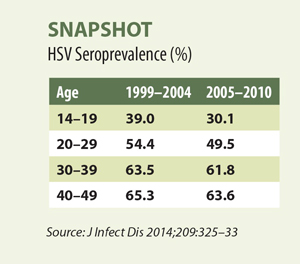Prevalence of Herpes Simplex Virus 1 Declining in Adolescents

New research indicates that in 2005–2010, fewer adolescents were seropositive for herpes simplex virus type 1 (HSV-1) in comparison to 1999–2004, signaling a change in epidemiology that has implications not only for disease patterns of both oral and genital herpes but also for HSV vaccine development, timing, and delivery strategies. Researchers at the Centers for Disease Control and Prevention and Emory University conducted the analysis using nationally representative data from the National Health and Nutrition Examination Survey (NHANES).
Across all age groups, the seroprevalence of HSV-1 in 2005–2010 was 53.9%, and the seroprevalence of HSV-2 was 15.7%. HSV-1 seroprevalence declined overall by 6.9% between 1999–2004 and 2005–2010, but was markedly lower in 14–19 year olds, going from 39% to 22.9%, which is a drop of >34% from peak HSV-1 seroprevalence in this age group in 1988–1994. HSV type-2 (HSV-2) seroprevalence also declined between 1999–2004 and 2005–2010, by 8.5%, with the greatest drop among 14–19 year olds, 1.6% to 1.2%, a 24% change.
The decline in HSV-1 seroprevalence mirrors that experienced in other developed countries. However, developed countries also have experienced increases in the proportion of HSV-1 rather than HSV-2-related genital herpes disease, which suggests that adolescents who lack HSV-1 antibodies before they become sexually active are susceptible to either HSV-1 or HSV-2 genital herpes infection. In addition, individuals who lack HSV-1 antibodies are more likely to develop symptoms when infected with HSV-2.
Although NHANES included questions about sexual behaviors, the authors were unable to examine patterns of genital HSV-1 infection in this analysis, so they couldn’t draw inferences about genitally versus orally acquired HSV-1. The authors concluded that the rising proportion of adolescents without HSV-1 antibodies "merits careful and ongoing surveillance."